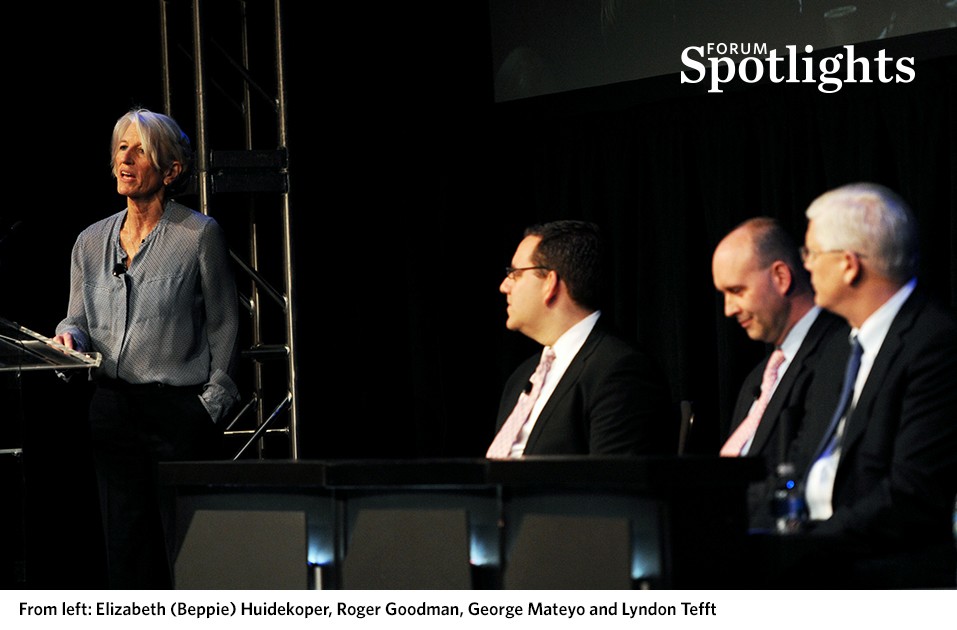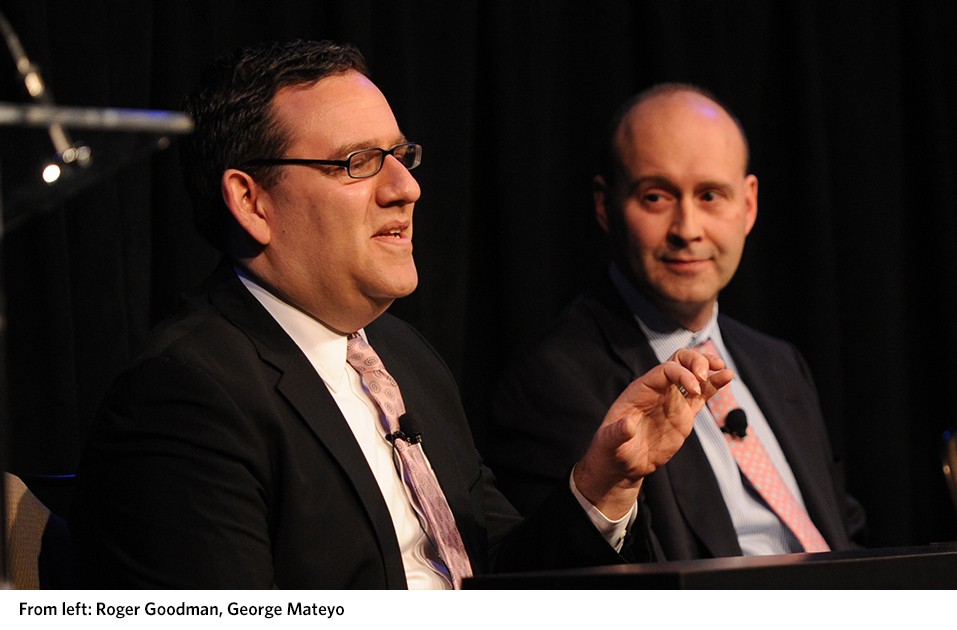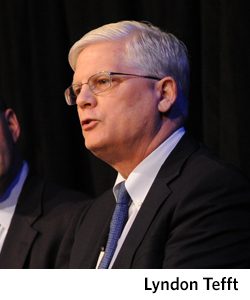Most things function a lot better when all the moving parts work together—nonprofit institutions included. The synergies afforded by collaboration across organizational boundaries may be the most underutilized way to leverage your organization’s resources.
At Commonfund Forum 2016, a panel discussion took on this issue. Excerpts from the exchange follow. The discussion was moderated by Elizabeth (Beppie) Huidekoper, former Executive Vice President, Finance and Administration, Brown University, and a Commonfund Trustee; Roger Goodman, Partner, Yuba Group; George K. Matyeo, Senior Director of Investments, Cleveland Clinic Health System; and E. Lyndon Tefft, Vice President and Chief Operating Officer, Commonfund.

Beppie Huidekoper: “The Big Picture” refers to a holistic view that integrates investments, operations, development and financial management. Our goal is to convey the idea that our institutional leaders need to work together to optimize sources and uses and assets and liabilities in the service of our missions. Teamwork really matters in this regard, as does empathy. In other words, it’s important for the investment side to understand the challenges the operating folks are facing, and vice versa.
Another point that’s critically important, especially at this time, is that leadership is a difference-maker—that is, the kind of leadership that brings people representing different perspectives together. Finally, original thinking—creative ideas and novel solutions—matters a great deal as well.
We will approach the big picture in two parts. First, the lessons learned from the financial crisis in 2008 and ’09 and some of the management solutions that have emerged since that time. Second, I hope to talk about what our institutions are currently doing with tools, analysis and planning to address their big picture challenges. For some of us in these tough times that may simply come down to survival and sustainability.
Lyndon, you served in both the finance and investment offices at Harvard. I was there at the time, mostly on the operations side. There was an interesting tension, if I may say it, between the two. The investment team would like the payout to be zero, have no constraints on cash and pursue the highest possible returns. The operations team would probably like the payout to be 10 percent and to have a lot of liquidity. Those are the extremes. Is that a little overstated?
Lyndon Tefft: Slightly. I worked in both areas—the university and the investment management company. At the university, we always thought of ourselves as a university with a hedge fund attached. When I went to the management company, it was a hedge fund with a university attached. But to the question of integrating those two, at the time we had no debt, and that’s where integration came in—discerning the role debt should play in a capital-intensive institution. The issues were how much debt, what structure, whether we should modify the portfolio’s investment policy in order to accommodate debt and liquidity considerations, and whether we should adjust the spending rate.

—Roger Goodman
Huidekoper: George, can you tell us the extent to which the Cleveland Clinic has been able to integrate investments, finance and development?
George Mateyo: We spend a lot of time thinking about the pools of capital that have been entrusted to us. We have four of them. One is operating funds for day-to-day operations, cash flow, checking accounts and overnight money. Then, we have a long-term investment portfolio, which is akin to an endowment or quasi‑endowment. Next, we have a defined benefit plan that serves pensioners, and we also have an offshore captive fund for insurance purposes. For most of my first year at Cleveland Clinic we thought hard about how these pools of capital are impacted by operations. It became pretty clear to me that I had to, at the very least, debunk the myth that health care is immune to the business cycle. The accepted wisdom is that people always get sick and that the economy doesn’t impact health care. But when we started diving into the numbers to understand some of the sensitivities to our portfolios and operations, we found that there’s a pretty tight correlation between the economy and our overall portfolio.
Huidekoper: Roger, since you joined Yuba, you’ve been helping all kinds of nonprofits optimize their debt and asset management. Can you share some of your thoughts and experiences about what happened in the 2008 crisis, and also some of the solutions you’ve come up with?
Roger Goodman: I was head of the higher education group at Moody’s in the summer of 2007. I certainly didn’t think this at the time, but looking back now, it actually was remarkable timing because it was such a unique point in time. At Moody’s we were visiting with different kinds of institutions in the midst of the crisis. We were talking to the Harvards, Yales and Princetons of the world, and they had a much different set of issues from those institutions that had relatively little endowment. We’d go from a meeting with people worried about what they were going to do next because there was this huge drop in the revenue stream that supports 40 percent of their operating budget to another institution that said, “You know, the impact on the endowment is going to barely eat up our contingency for the year.”
Most of what we saw coming out of the crisis was an issue of organizational structure and priorities. A lot of what we concluded was that for some institutions, the priority had been measurement against peers—is our return as good as someone else’s? Those institutions built their portfolios on aspirations rather than thinking about the connection to the risk side, the operating budget and other issues that might be unique to their institution. We saw some of that, and we saw some structural issues where the endowment had become too separate from the rest of the institution or—and I’ll use a not so popular description—too powerful compared to the rest of the institution. When there was disagreement or when there were competing priorities between endowment policy/investment decisions versus finance decisions, the endowment tended to win. In retrospect, internal struggles exacerbated problems during the financial crisis.

So, what we have worked on in the last few years is trying to balance competing priorities. While we’re mostly a debt adviser, there’s always a link to things like how debt structure can impact liquidity needs, the investment approach and the budget. We want to optimize our cash position, make sure we’re earning sufficient return on that portion and not be overly liquid. We want to optimize the debt structure, have a lower cost of capital, take advantage of all the great rates available right now, but we also have this long-term capital plan and we need to be thinking about needs down the road—when should we borrow, when will we need liquidity, when are we expecting gifts to come in? It’s that kind of balancing act.
Huidekoper: What’s the management solution to these problems?
Mateyo: One thing that’s unique about Cleveland Clinic is the fact that it’s a physician-led organization. With the exception of the CFO, the Chief Legal Officer and a few others, the organization is led by physicians and they think of themselves as an integrated unit. That approach to integration is the glue that allows us to work the way we do. Everybody is there to learn from each other, to collaborate. So, for instance, how the investment portfolio fits within the organization is really important for our colleagues in finance to understand, or how the philanthropic component relates to the investment portfolio.
Huidekoper: What risks should our institutions be focusing on and what are some of the management or information tools that you would suggest?
Tefft: One of the issues that emerged during the financial crisis was a desire to have variable rate debt. The common structure carried with it a lot of liquidity risk, very short-term liquidity risk. It was a balance—you really wanted low variable rates, and that was matching a working capital portfolio. So, there was a nice, natural hedge. But, at the same time, it brought liquidity risks into the capital structure.
There are new structures out there that are really just direct bank lending and, ironically enough, it’s really what the rest of the world does. For nonprofit organizations, especially smaller ones, to be borrowing in the public capital markets is a strange phenomenon of the U.S. market. So, this idea of getting access to something that’s a variable rate debt product but without all of the liquidity risks is one key development to come out of the financial crisis.
I would say the other is a lot of focus on better across-the-board financial reporting. This varies by institution, but making sure that financial reports that are directed to the trustee level are not overly siloed is important. In other words, there’s not a total focus on the operating budget and how much of a contingency we have, or how much liquidity we have in our operations, and a completely different report looking at endowment liquidity and endowment financial metrics. It may mean a pretty big investment in information technology, but even beyond that it’s a matter of getting into the practice of producing comprehensive financial reports that every different trustee group is seeing.

—George Mateyo
 Huidekoper: Lyndon, you’ve been working with a number of Commonfund institutions, helping them on the operating side. Can you talk about how our collective institutions might be thinking about sustainability over time?
Huidekoper: Lyndon, you’ve been working with a number of Commonfund institutions, helping them on the operating side. Can you talk about how our collective institutions might be thinking about sustainability over time?
Tefft: Commonfund is an investment firm—we focus on investments, spending and so forth. When I first arrived at Commonfund, we talked with our clients a great deal about intergenerational equity, essentially the ability to preserve the power of the endowment and yet support the mission. Obviously, very important. But I felt like I had landed on an alien planet because I thought about intergenerational equity in a much wider dimension, and it wasn’t all about endowment. It was about facilities. It was about faculty. It was about your student body, your health care practice, your technology needs. I wanted to widen out this perspective. All these institutions had strategic plans or master plans. They all had budgets. They were doing a lot, but it was disconnected and it raised the question of how one can go beyond a financial statement and look across the enterprise’s resources and build a framework for making conscious choices about the trade-offs that confront every institution. So, fragmentation is a problem along with being overly concerned with precision.
Goodman: That’s an important point—it’s OK to sacrifice a little on the precision side. Some of what we saw was simply too granular, so we came up with the acronym CALM—which some trustees snickered at because the markets we deal in are never calm—that stands for Comprehensive Asset/Liability Model. We took all these things together and said, “Look, we’re not going to be ultra-precise about everything. We’re not going to capture every detail of what we’re trying to do. But we will understand linkages across the entire enterprise and how they impact the balance sheet.” From that we developed something even simpler that was really just a hierarchy of needs that was kind of based on Maslow. What’s the hierarchy from an operational perspective, from a debt perspective, from cap ex and so forth? We took the balance sheet and split it into two camps: a preservation pool or funds that wouldn’t be needed for a long, long time and, after that, some money that’s set aside for strategic growth initiatives. We sacrificed some precision because we felt that, frankly, perfection was the enemy of progress.

—Lyndon Tefft
Huidekoper: A closing thought from everyone. George?
Mateyo: Health care is probably at the greatest stage of transformation since the New Deal. So, transformation is a big part of how we think about managing the portfolio and the finances of Cleveland Clinic. It goes back to two things. One that Roger mentioned was the hierarchy of needs concept in which you are shoring up the balance sheet and meeting operating needs first but investing in longer-term strategic growth as well. Second, we work hard at being very innovative. We pay a lot of attention to developing new ideas inside the system, whether they be clinical at the bedside or greater financial and operational efficiencies. We have a team of roughly 50 people inside our organization who are focused on innovation. In the last 10 years, we’ve actually birthed about 75 companies that are generating revenues and, more importantly, benefiting patients.
Goodman: Two points I would make. The biggest challenge we see facing most institutions is where to get the capital to make investments. You might want to start a new program but the budget system is set up in such a way that finding those dollars is a real challenge. So, we would say a reasonable strategy for the longer term is to create enough room to actually be able to invest annually in new ideas … in a kind of “test kitchen” approach to see what works.
The other side of it, though, is a lot of discussion about real estate strategies and other ways to build new revenue streams. We worry quite a bit about swinging too far in that direction, and we’ve seen some transactions that sell off assets and put the institution at a disadvantage. It’s shortsighted to engage in a transaction that avoids debt issuance today, but gives up what would likely be a long-term revenue stream. It comes back to the intergenerational equity issue—you may be sparing yourself a rating downgrade today but giving up too much for the long term.
Tefft: I would try to discern what’s really important to the core of your institution, and then understand whether the choices you make today are going to limit or expand your choices tomorrow. It’s a process, an ongoing discussion, not modeling or financial engineering. Finally, I’m always struck by the resiliency of the institutions I work with. They’ve been through so much, so many different things, but they are enormously resilient. I wouldn't understate the challenges that lie ahead. But I would not overlook the resiliency of the nonprofit sector.


